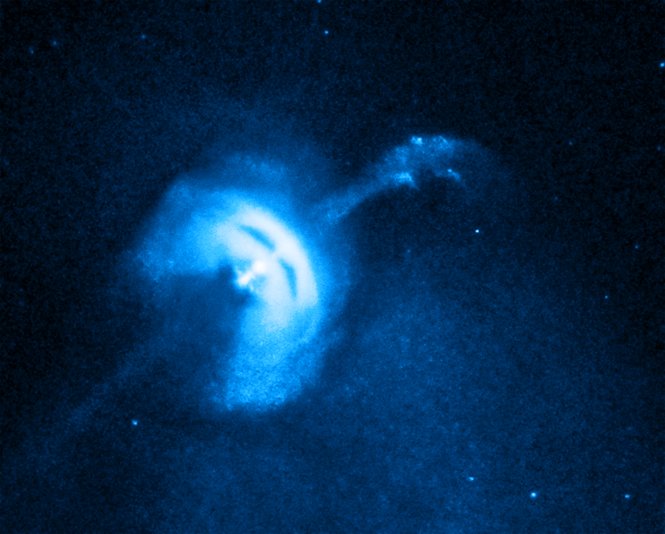
 Credit: X-ray: NASA/CXC/Univ of Toronto/M.Durant et al; Optical: DSS/Davide De Martin
Credit: X-ray: NASA/CXC/Univ of Toronto/M.Durant et al; Optical: DSS/Davide De Martin
Turn Around
Pulsars are rapidly rotating cinders left behind by the terminal evolution of stars which start out with about 5 to 10 times the mass of our Sun. Pulsars are the dead remnants of the core of the star, which collapses at the end of the star's life so that all the charged sub-atomic particles (protons and electrons) are squeezed into neutrons (in a process called inverse beta decay). The neutron star that's produced has an incredibly high density (so that 1 teaspoonful of neutron star material would contain more mass than the combined human population of earth), and the relatively leisurely rotation of the progenitor star becomes amplified in the collapse. The high spin rates and strong magnetic fields of neutron stars make them arguably the most extreme objects in the Universe. A famous example is the Crab Nebula Pulsar, while another is the Vela Pulsar. The Vela pulsar rotates once every 89 milliseconds, much faster than the rotation of the propeller of a helicopter (which rotates at typically less than 5 rotations per second). Because of a neutron star's high density, you might expect them to be perfectly smooth and spherical. But stresses in a neutron star's solid iron crust can break the crust and generate titanic starquakes. And even slight asymmetries in the distribution of a neutron star's mass can cause it to wobble, and generate gravitational waves as a result. The image above (and the associated movie) of the Vela Pulsar by the Chandra X-ray Observatory seems to show a precessing jet of material being ejected from the neutron star, perhaps showing the wobble of the neutron star.
Published: January 21, 2013
<
HEA Dictionary ● Archive
● Search HEAPOW
● Other Languages
● HEAPOW on Facebook
● Download all Images
● Education ● HEAD
>

Each week the HEASARC
brings you new, exciting and beautiful images from X-ray and Gamma ray
astronomy. Check back each week and be sure to check out the HEAPOW archive!
Page Author: Dr. Michael F. Corcoran
Last modified Monday, 26-Feb-2024 17:24:21 EST


